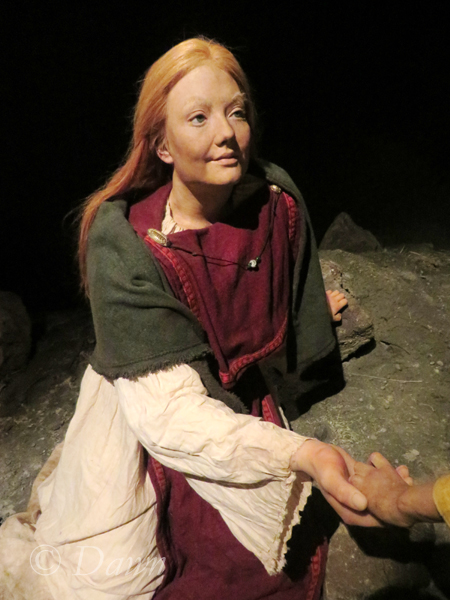In a previous post, I showed off one of the styles of apron dresses shown on wax figures representing characters from Icelandic sagas at the Saga museum. Here I’m going to show off all of the different reproduction styles on display.
Hallveig Fróðadóttir, 874
This first display is of “Ingólfur Arnarson, who came to the country with his wife Hallveig Fróðadóttir in the year 874” –Saga Museum, and in this display they’ve portrayed the character wearing an apron dress that may be somewhat fitted through the bust and waist, with a flared skirt, and a curved shaped armhole.
Based on the reading I’ve done so far, it looks like a more fitted style like this might be is dated to the 10th Century (rather than the 9th as this display portrays) from finds in Hedeby and Birka.
Melkorka Myrkjartansdottir
The next figure is wearing a drastically different apron dress – this one appears to be nothing more than two panels of fabric, folded at the top and pinned at the shoulders. The figure doesn’t appear to be wearing a belt to keep the over-garment from twisting around, falling into the fire, being blown about by wind… etc. The panel on the front is trimmed on the side edges such that the trim shows on the “wrong” side of the top part of the garment, and the “right” side of the lower part of the garment.
This style seems to be a variation of the Ancient Greek and Roman Peplos, which evolved considerably into the Viking Apron dress. However, this style does seem to have some later historical finds backing it up – from about 1000 CE. In Finland.
“Peploses were worn later in time in many northern European areas, such as in Anglo-Saxon England, and evidence that a similar garment was still being worn around the year 1,000 C.E. was found in a grave in Eura, Finland.” – Cathy Raymond
In a document from an issue of the Compleat Acachronist (Issue #59) it is suggested that this peplos-style apron dress was used by the people in the area prior to what is known as the “Viking Age”. (Keeping in mind that the people living in the area now Finland were not “Vikings”.)
This figure’s display isn’t dated, but it comes before 1000 CE, and after 874 CE, so although it’s depicted as a more recent story than the first display, the figure is wearing an apron-dress in a style that is far, far older.
Another peplos-style apron dress: Freydis Eiriksdottir
The character above is also wearing a peplos-style apron dress. It too is two pieces of fabric, folded at the top, and pinned at the shoulder. There are no side seams but this character does have a belt on at least. This display also wasn’t dated, but would be about 1000 CE.
Another peplos-style: Thorbjorg litilvolva
The final figure is also undated, but also wears a peplos-style apron-dress more aligned to a much older fashion, or fashion attributed to a different region and not Iceland. This is unadorned, apart from a contrasting band at the hem.
Conclusions
Like the previous post from the Saga Museum, I’m unsure if the inconsistencies between my other research and the apron-dresses displayed at the Saga museum are backed by their own historical research, if perhaps they developed their display based on Finnish models, or if perhaps they just represent inaccuracies.
With that in mind, although I enjoyed the displays, I don’t think I’m going to base any of my costuming research off their displays.
Sagamuseum – The Saga Museum
www.sagamuseum.is/
Grandagarður, 101 Reykjavík, Iceland
+354 511 1517




















